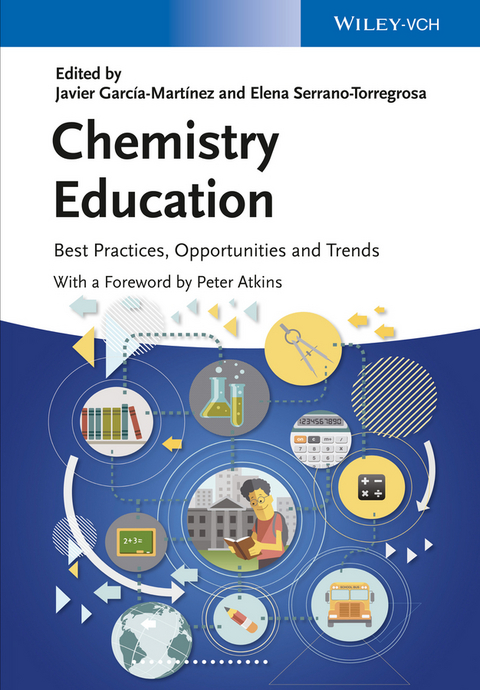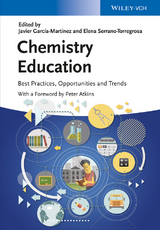Chemistry Education
Wiley-VCH (Verlag)
978-3-527-33605-0 (ISBN)
Javier García-Martínez is Faculty member and Director of the Molecular Nanotechnology Lab at the University of Alicante, Spain, where he teaches at undergraduate and graduate levels, and created several courses on materials chemistry and nanotechnology. Javier has published extensively on chemistry, materials science, and nanotechnology and is inventor of more than twenty fi ve patents. He is Co-founder of Rive Technology, a VC-funded MIT spin-off commercializing hierarchical zeolites for energy applications and a fellow of the Royal Society of Chemistry, member of the Global Young Academy, the World Economic Forum, and of the Bureau of the International Union for Pure and Applied Chemistry. His latest books are "Nanotechnology for the Energy Challenge" (Wiley, 2014) and "The Chemical Element" (Wiley, 2011). Elena Serrano-Torregrosa is a Research Fellow at the Molecular Nanotechnology Lab of the Inorganic Chemistry Department at the University of Alicante (Spain), where she has been teaching since 2009 and has created several courses on nanotechnology. She received her PhD in 2006 at the University of Basque Country, Spain (Iñaki Mondragón). After a post-doctoral activity at the National Institute of Applied Sciences, INSA in France (Jean-Pierre Pascault), Elena joined the Molecular Nanotechnology Lab at the University of Alicante in 2009. Her current research interests are in the area of new synthetic pathways to prepare photoactive hybrid titania-based materials, in which she is working for three years. Her last book is "The Chemical Element" (Wiley, 2011).
PART I Chemistry Education: A Global Endeavour
#01 Chemistry Education and Human Activity
#02 Chemistry Education That Makes Connections: Our Responsibilities
#03 The Connection Between the Local Chemistry Curriculum and Chemistry Terms in the Global News: The Glocalization Perspective
#04 New Perspectives on the Undergraduate Chemistry Curriculum in Universities
#05 Empowering Chemistry Teachers? Learning: Practices and New Challenges
#06 Lifelong Learning: Approaches to Increasing the Understanding of Chemistry by Everybody
Part II Best Practices and Innovative Srategies
#07 Using Chemistry Education Research to Inform Teaching Strategies and Design of Instructional Materials
#08 Research on Problem Solving in Chemistry
#09 Do Real Work, not Homework
#10 Context-Based Learning on School and University Level
#11 Active Learning Pedagogies for the Future of Global Chemistry Education
#12 Inquiry-Based Student-Centered Instruction
#13 Flipping the Chemistry Classroom with Peer Instruction
#14 Innovative Community Learning Projects: from Chemical Reactions to Community Interactions
#15 The Role of Conceptual Integration in Understanding and Learning Chemistry
#16 Learner's Ideas, Misconceptions and Challenge
#17 The Role of Language in the Teaching and Learning of Chemistry
#18 Using the Cognitive Conflict Strategy with Classroom Chemistry Demonstrations
#19 Chemistry Education for Gifted Learners
#20 Experimental Experience through Project-Based Learning
#21 The Development of High-Order Learning Skills in High School Chemistry Laboratory: "Skills for Life"
#22 Chemistry Education through Microscale Experiments
Part III The Role of New Technologies
#23 21st Century Skills: Using the Web in Chemistry Education
#24 Design of Dynamic Visualizations to Enhance Conceptual Understanding in Chemistry Courses
#25 Chemistry Apps on Smartphones and Tablets
#26 E-Learning and Blended Learning in Chemistry Education
#27 Wiki Technologies and Communities: New Approaches to Assessing Individual and Collaborative Learning in the Chemistry Llaboratory
#28 New Tools and Challenges for Chemical Education: Mobile Learning, Augmented Reality and Distributed Cognition in the Dawn of the Social and Semantic Web
| Erscheint lt. Verlag | 18.3.2015 |
|---|---|
| Verlagsort | Berlin |
| Sprache | englisch |
| Maße | 170 x 244 mm |
| Gewicht | 1795 g |
| Themenwelt | Naturwissenschaften ► Chemie ► Allgemeines / Lexika |
| Sozialwissenschaften ► Pädagogik | |
| Schlagworte | Allg. Naturwissenschaft • Bildungswesen • Chemie • Chemiestudium • Chemieunterricht • Chemistry • Education • General K-12 School • General Science • Hochschule • Hochschulen / Lehren u. Lernen • K-12 School • Science/Chemistry/K-12 • Teaching & Learning (Higher Education) • Teaching & Learning (Higher Education) |
| ISBN-10 | 3-527-33605-2 / 3527336052 |
| ISBN-13 | 978-3-527-33605-0 / 9783527336050 |
| Zustand | Neuware |
| Haben Sie eine Frage zum Produkt? |
aus dem Bereich




